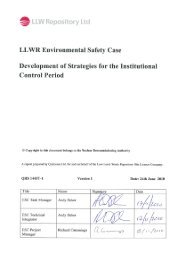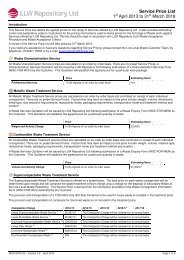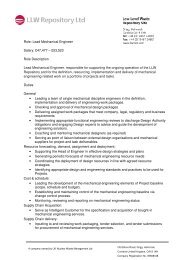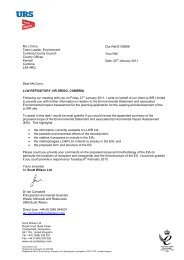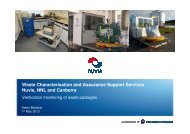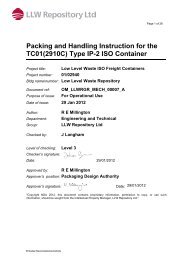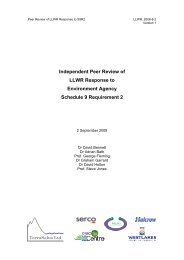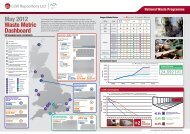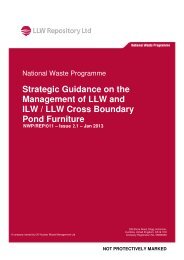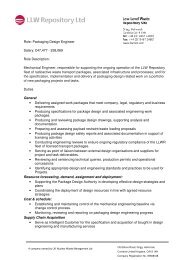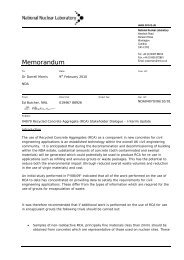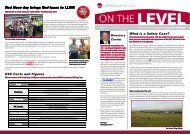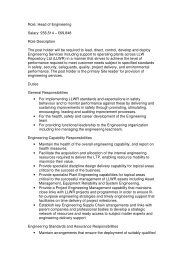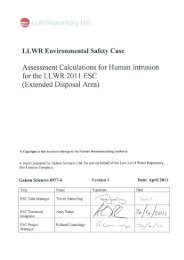Developed Operational Strategy - Low Level Waste Repository Ltd
Developed Operational Strategy - Low Level Waste Repository Ltd
Developed Operational Strategy - Low Level Waste Repository Ltd
You also want an ePaper? Increase the reach of your titles
YUMPU automatically turns print PDFs into web optimized ePapers that Google loves.
LLWR <strong>Developed</strong> <strong>Operational</strong> <strong>Strategy</strong>10009/LLWR/LTP Date: March 2010be discussed through the UK LLW <strong>Strategy</strong> Group. The aim of this strategy is the development ofstandardised characterisation procedures for waste streams and packaged wastes. These mayeventually replace those existing practices that conservatively assign container inventories based onbroad characterisation data collected during waste planning.Whilst there will still be variation in the quality of characterisation across all consignors, this standardisedapproach will offer many benefits:• Reduction in pessimistic declarations for low level waste disposal• Improved opportunities to identify and segregate VLLW and Exempt <strong>Waste</strong> (EW)• Reduced transport and packaging requirements• Opportunity to reduce current volumes of waste identified as Intermediate <strong>Level</strong> <strong>Waste</strong> (ILW)Robust characterisation will allow for a more accurate classification of waste streams and packages and,when the conservative uncertainties are removed, will result in a larger fraction of waste consigned asEW or VLLW. Experience with similar waste package characterisation programmes in the United States(U.S.) has demonstrated that more accurate characterisation practices produce results well below theconservative methods typically employed by many consignors. Defining requirements for wastecharacterisation improvement in terms of radioactivity and nature of waste will result in better confidenceand assurance of the national LLW inventory dataset and waste inventories modelled in the LLWR ESC.Consultation with consignors is an essential part of this strategy, as each site is best placed tounderstand its own waste. LLW <strong>Repository</strong> <strong>Ltd</strong>.’s role is to facilitate the sharing of good practices andthe development of a standardised guidance for characterisation. This will ultimately form part of theacceptance criteria for the LLWR. Where there are barriers that prevent the implementation of thisapproach at consignor sites, due to capital expenditure costs for example, LLW <strong>Repository</strong> <strong>Ltd</strong>. will lookto develop new services that support improved characterisation by utilising relevant resources in thesupply chain. LLW <strong>Repository</strong> <strong>Ltd</strong>., through the Consignor Support Team, will continue to provideguidance and support to consignors in their waste characterisation activities.If required, Consignor Support representatives will be able to provide training to consignor wastemanagement personnel, support consignor implementation of standardised waste managementprocedures, and facilitate sharing of waste management lessons learned and best practice. This will beachieved by support visits to consignor sites where the Consignor Support Team can provide direct helpand assistance to consignors. A characterisation specialist has been engaged in order to providesupport to the consignors in implementation of this strategy.A strategic review has been carried out to re-consider the most appropriate options for verificationmonitoring of uncompactable waste at LLWR. The existing strategy was to use a LLW Activity Monitor,which was intended to improve monitoring of uncompactable waste. The review concluded that thiswould not provide the required flexibility in approach to meet a range of waste management options andvarious waste forms and packaging. An assessment of alternative options identified that a moreappropriate approach for the verification monitoring of uncompactable waste, could be provided by an In-Situ Object Counting System (ISOCS) High Resolution Gamma Spectrometer. This has been selecteddue to it’s technical capability, flexibility in deployment, the ease and safety of operations and theminimum capital costs required for implementation. This technique for the monitoring of uncompactablewaste at LLWR was implemented during 2009. The service is provided by the supply chain via an initialcontract to monitor 20 consignments. Consignments for monitoring are identified on a risk basedPage 18 of 62



